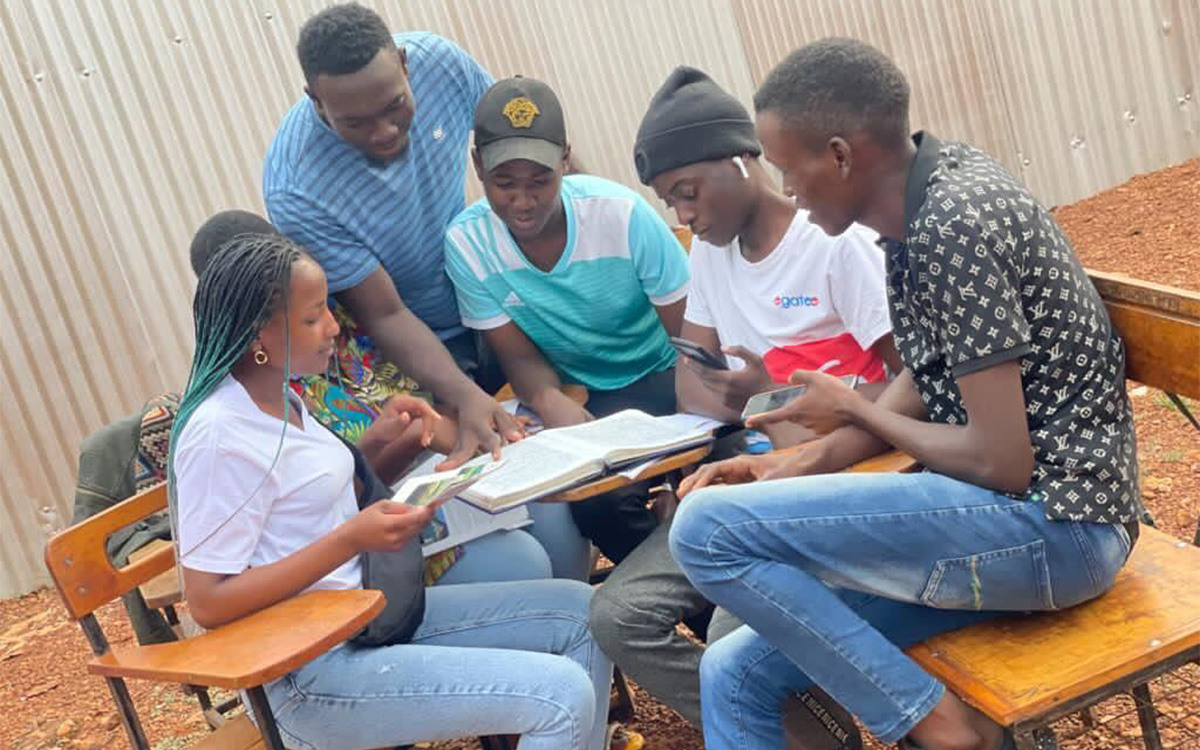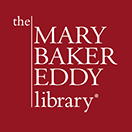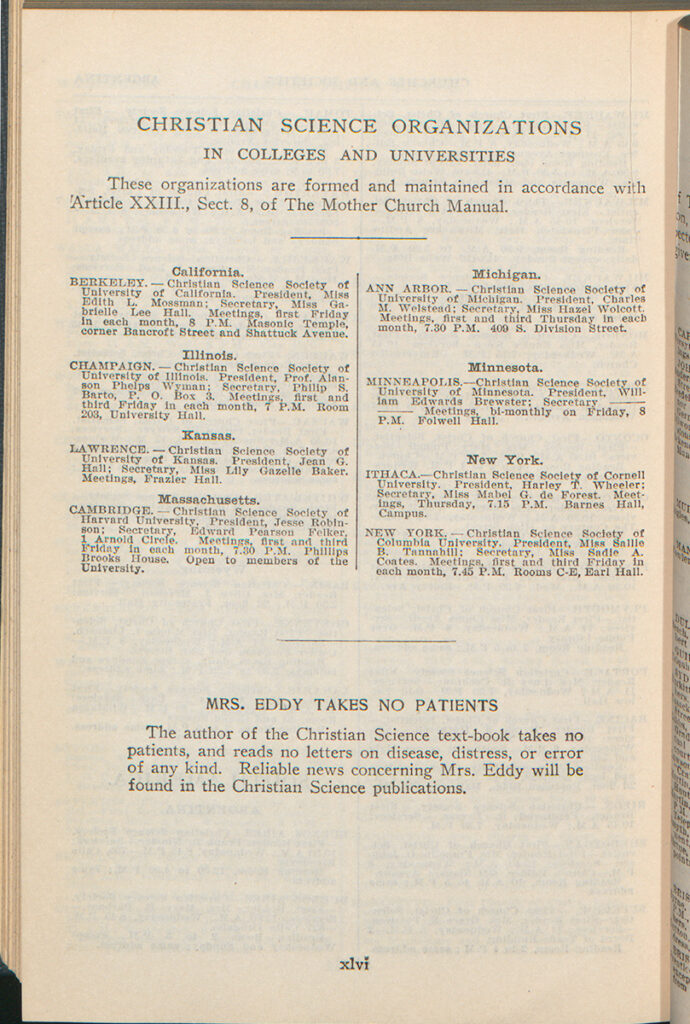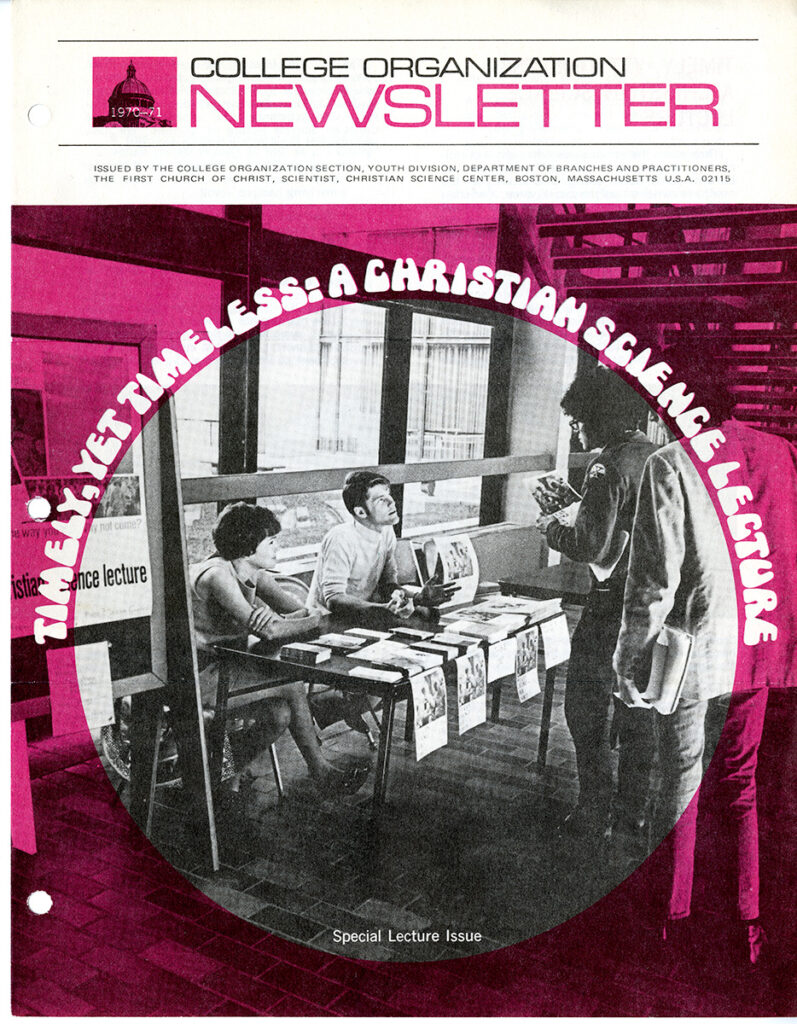From the Collections: Christian Science on college and university campuses

Members of the Christian Science organization at Ndejje University in Kampala, Uganda, 2022. Photo by Ssenabulya Elvis. Courtesy of Christian Science organization at Ndejje University.
It was at the request of a Harvard University student that Mary Baker Eddy decided to include a provision for Christian Science organizations (CSOs) in a By-Law of the Church Manual, the governing document for The First Church of Christ, Scientist (The Mother Church).1 Today CSOs are found at colleges and universities in many countries,2 providing opportunities for students and faculty to come together to have a healing impact in their university communities. This article considers the history of these organizations, exploring their enduring purpose and potential to meet the varying needs of institutions around the world.
Beginnings: Literature and lecturing, Wellesley and Harvard
Before the development of CSOs, there was already an interest in sharing Christian Science at universities and colleges. For instance, a notice in the December 1895 Christian Science Journal announced that Eddy’s book Science and Health with Key to the Scriptures had been placed in several college and university libraries.3
In April 1901, Carol Norton lectured to a large group at Cornell University on the topic “A Third of a Century of Christian Science.” This talk was sponsored by the university administration.4
Evidence of early CSO activity can be found in connections that students made with one another at Wellesley College, an all-women’s college in Wellesley, Massachusetts. In the spring of 1901, the Wellesley students wrote individual letters to Eddy. She responded:
Allow me to say, your kind Easter greetings are fortunate to get answered. Even with little time for social converse I can not deny myself the pleasure of a word to the Wellesley “nine” — of thanks for your dear letters, each one is no doubt characteristic…. Press on in the higher hope and you will help the whole world to be better and wiser for your early choice of the one thing needful.5
Similarly, students at various colleges and universities in Boston and Cambridge were gathering together off-campus between 1898 and 1904, to connect with one another while listening to speakers on Christian Science.6
Perhaps out of a desire to formalize their activities and move them onto the Harvard University campus, in 1904 student Wilfred Cole began a correspondence with Eddy, asking for a provision in the Manual for Christian Science organizations at universities. She sent him a draft By-Law, in which he replied, “I cannot too strongly express my gratitude, at the vista of glorious possibilities now opening up to the educational world.”7
In March 1904, Eddy requested the By-Law be placed in the Manual.8 This is how it appears today:
Members in good standing with The Mother Church, who are members of the faculty, instructors, or students in any university or college, can form and conduct a Christian Science organization at such university or college, provided its rules so permit. Also members in good standing with The Mother Church, who are graduates of said university or college, may become members of the organization by application to, and by the unanimous vote of, the active members present, if the rules of the university or college so permit. When called for, a member of the Board of Lectureship may lecture for said university or college organization.9
A few months later, a group of students and recent alumni at Harvard established the first formal Christian Science organization. The group later shared details of a testimony meeting they hosted, in a letter to Eddy that was published in the Sentinel:
A senior and a law student spoke of the good results that had come from the daily study of Science and Health. The senior said he could accomplish more in his daily college work when he interspersed with it the reading of our text-book. The law student said this study had replaced gloom, and a dread to begin each day, with a sense of confidence and peace….10
The first directory page for Christian Science organizations in the September 1910 issue of The Christian Science Journal.
Early CSO activity
CSOs were first listed in the Journal directory in September 1910, primarily in the United States at schools on the East Coast and in the Midwest. At this point they were referred to as Christian Science Societies. While CSOs were still predominantly located in these same regions by the mid-1930s, eight had been established in California, with one each in Seattle, Washington, and Austin, Texas. Additionally, by this point there were two CSOs in the United Kingdom, at Cambridge University and Oxford University. Starting in 1927, some groups were referred to as organizations, rather than societies. This was a gradual change; by June 1942 all groups had changed their names.
One example of early CSO activity can be found in a 1913 Sentinel notice about the Society of the University of Chicago. This group hosted bi-monthly meetings open to both Christian Scientists and others in the campus community. That same year, it also hosted a public lecture, where introductory remarks by Derwent S. Whittlesey referred to the purpose of regular meetings as a way to manage the pressures of college life:
… No matter how secure [the student’s] mental anchorage may be, the society’s bimonthly meetings of exchange of experience help him … by applying his faith in God to the every-day needs of an active college life. Here he gains courage to stand before the challenge of the modern critics of the Bible, and to stand calmly, with the assurance that he has found in Christian Science a scientific and at the same time a Christian rule of living….11
International development
Formal CSO activity began in countries outside the United States in 1929, with the formation of the CSO at Oxford. Other examples, which are not comprehensive, include a group at the University of Sydney, first listed in the Journal in 1949. Another was listed at the University of Paris in 1953. University members at the University of Buenos Aires formed a CSO in 1960—the first in South America to be listed. Starting in 1969, there were CSOs in the cities of Jakarta and Yogyakarta, Indonesia.12
At one point, an informal group of Christian Scientists studying at universities in Tokyo connected with one another to hold meetings. They also presented a Christian Science lecture (sponsored by the Christian Science Board of Directors) in 1968. One CSO member noted that the lecture provided clarity on how they could follow God’s plan for their studies.13
Students and faculty formed a CSO at Marien Ngouabi University in Brazzaville (Republic of Congo) in March 2003. At that time the group was holding informal weekly meetings, one per month being time for sharing testimonies of healing.14
As of 2024 CSOs are active in the following countries: Benin, Burundi, Cameroon, Democratic Republic of Congo, Liberia, Republic of Congo, Nigeria, Rwanda, Togo, and Uganda, United Kingdom, and the United States. At different times, The Mother Church has provided regional representatives to support local Christian Scientists in their desire to form and run CSOs. Currently, there are representatives for English-, French-, German-, Portuguese-, and Spanish-speaking countries around the world. You can reach The Mother Church CSO Support Team at [email protected].
What is a CSO?
CSOs exist to provide a public presence of Christian Science at a college or university. The range of activities are diverse and often unique to each entity. Frequently they engage in activities that include hosting regular gatherings, participating in interfaith events, and sponsoring Christian Science lectures. These activities have continued since the adoption of the Manual By-Law in 1904.
Because that By-Law only mentions the hosting of lectures, what other activities can a CSO take on? The Mother Church has developed its own guidelines over the years to help bring the activity into conformity with other forms of church organization. Most notably, this once took form in various recommendations and requirements (since rescinded) for Journal-listed CSOs to organize themselves with bylaws and officers, including a Reader who would conduct weekly or bi-weekly church services. Specifically, the services were meant to resemble testimony services at Christian Science branch churches.15
In fall of 1980, for example, the CSO at the University of Maryland held weekly testimony meetings at noon on Mondays. They were already planning a lecture for the spring on the topic “Quit Conspiring Against Yourself!” In addition, they maintained (and continue to maintain) a study room on campus “open to anyone for religious study.”16
College Organization Newsletter, June 1970. Church Archives, The First Church of Christ, Scientist.
A shift in the approach to CSO activity
By the early 1990s, The Mother Church was moving away from extensive listing requirements, which were not in the Manual By-Law for CSOs. In November 1996, a statement by the Executive Manager of the Office of the Clerk appeared in the Journal and included this:
Our office has been supporting and engaging Christian Science organizations (CSOs) at colleges and universities worldwide in a reexamination of their purpose by an in-depth look at the Church Manual By-Law, Article XXIII, Section 8. As a result, CSO members are bringing an awareness of the Science of the Christ to those seeking spiritual answers, and they are healing important issues within their campus communities.17
The church began promoting more flexibility in CSOs, so that they could respond to the particular needs of schools in the ways they saw best. Along these very lines of rethinking what a CSO could be, the author of this article founded a CSO at the University of Mary Washington (Fredericksburg, Virginia) in 2002, with just one member. The following year it hosted a Christian Science lecture for the campus.
This new approach led to greater diversity of activity. For instance, between 2005 and 2007 students in a CSO at the University of Arizona met almost every week, sitting outside on patio chairs to share inspiration and testimonies with one another. Sometimes members of the group would bring passages from the Bible or Eddy’s writings that they found helpful or relevant to campus situations.18 CSOs can also hold more formal meetings—the one at Principia College in Elsah, Illinois, currently holds both Sunday and Wednesday church services, as well as other activities that include hymn sings and informal discussions.
In order to be listed in the Journal, new CSOs must include at least one member of The Mother Church who is also a student or faculty member, and the group must operate under the rules of the college or university. Because there are no published requirements for when or how to hold meetings, CSOs may meet on their own schedules and in the formats that best meet their needs.
What else can CSOs do?
CSO activities continue to include hosting speakers for interfaith discussions and classroom lectures. In the late 1960s, for instance, an informal CSO at the University of Stockholm, Sweden, sponsored an event that would share Christian Science with other faith groups. The event was so successful that plans were subsequently made to host a larger series of interreligious events.19
Some CSOs manage spaces where the community can find spiritual refuge and healing. The University of Houston’s CSO currently staffs a room with Christian Science literature, open several hours per week. Other CSOs distribute literature, including The Christian Science Monitor, at events such as student activity fairs.
Numerous examples of the impact of CSO activity include testimonies published in the Christian Science magazines. For instance, a university student was unable to find housing at the beginning of the semester. She had tried all avenues, but had come up empty-handed. Seeing one day the sign on the door of the campus CSO, she decided to come in and ask for help. One CSO member shared some healing ideas from the Bible and they prayed together. Soon afterward, the student returned to the CSO rooms to gratefully report that she had found housing.20
A CSO member in Cameroon shared a healing of a severe burn that happened while preparing food. He was scheduled to lead his CSO meeting later that day, and felt prayerfully led to attend. By the time he returned home that evening, he had forgotten the problem. In fact, the condition had lessened greatly, and he was healed in a few days.21
What are your CSO stories?
For further reading on a related topic, see our website article “A history of Christian Science youth meetings.”
This article is also available on our French, German, Portuguese, and Spanish websites.
- See “Privilege of Members,” in Mary Baker Eddy, Manual of The Mother Church (Boston: The Christian Science Board of Directors), 73.
- CSOs are listed in The Christian Science Journal and on the JSH-online website.
- “During the past year a faithful and energetic worker …,” Journal, December 1895, 352.
- “The Lectures,” Christian Science Sentinel, 18 April 1901, 525-526. To learn more about Norton, see Yvonne Cache von Fettweis and Robert Townsend Warneck, Christian Healer: Amplified Edition (Boston: The Christian Science Publishing Society, 2009), 480-481.
- Eddy to Emma Shipman / Undergraduates of Wellesley College, 13 April 1901, L08916.
- See “Christian Science Society of Harvard University,” in “Progress of Christian Science,” Journal, May 1912, 100–101. On February 26, 1904, a student at Harvard, Edwin C. Johnson, wrote to Eddy asking for her permission to host speakers on campus. See 683a.77.013.
- Wilfred G.G. Cole to Eddy, 24 February 1904, 057.16.002.
- Eddy to The Christian Science Board of Directors, 4 March 1904, L00850.
- Eddy, Manual, 73. This By-Law is Article XXIII, Section 8.
- “Letters to our Leader,” Sentinel, 1 July 1905, 710.
- “The Lectures,” Sentinel, 19 July 1913, 913.
- This group was listed under the name Jogjakarta in the Journal Directory.
- “From Tokyo, Japan” in News from College Organizations, February 1969. Church Archives.
- Church Archives.
- For example, see “Item of Interest,” Sentinel, 28 October 1933, 171–172. See also The First Church of Christ, Scientist, “Recommendations concerning bylaws for Christian Science organizations at colleges and universities” and “Some facts about forming Christian Science organizations at colleges and universities,” August 1967, Church Archives, Box 47895, Folder F295616. See also The First Church of Christ, Scientist, “The Meetings of Christian Science Organizations,” in Appendix E of Reference Notebook for Regional Assistance, 1984, Church Archives, Box 47895, Folder 279324.
- Christian Science organization at the University of Maryland to Area Maryland and District of Columbia Churches of Christ, Scientist, September 1980, Church Archives, Box 47895, Folder 201344671.
- Dorothy Howell Cork, “Sharing the Christ message—a healing force in cities and on college campuses,” Journal, November 1996, 46. See also Evan Mehlenbacher, “CSO’s—Making the Connection,” Journal, November 1992, 43–44.
- Author’s personal experience.
- “Spiritual fellowship and brotherhood in action,” in College Organization Newsletter, November 1970. Church Archives.
- Beverly Goldsmith, “College housing crunch yields to prayer,” Sentinel, 20 October 2005, web original.
- Bernard Sango Njanseb, “Rapid healing of a burn,” The Christian Science Journal, January 2014, 39–40.



